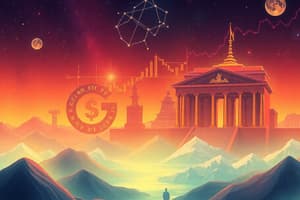Podcast
Questions and Answers
What does the income approach measure GDP by summing?
What does the income approach measure GDP by summing?
incomes that firms pay households for the factors of production they hire
What are the two broad categories of incomes included in the income approach for measuring GDP?
What are the two broad categories of incomes included in the income approach for measuring GDP?
- Interest, rent, and profit
- Social Security and pension fund contributions
- Corporate profits and proprietors' income
- Wages, salaries, and other labor income (correct)
Net interest, rental income, corporate profits, and proprietors' income earned by capital and land are included in the blue flow OFI as part of _ _ _.
Net interest, rental income, corporate profits, and proprietors' income earned by capital and land are included in the blue flow OFI as part of _ _ _.
Other factor incomes
Real GDP is the value of final goods and services produced in a given year when valued at the prices of a reference base year.
Real GDP is the value of final goods and services produced in a given year when valued at the prices of a reference base year.
What does GDP stand for?
What does GDP stand for?
Which components are included in the calculation of GDP? (Select all that apply)
Which components are included in the calculation of GDP? (Select all that apply)
GDP is a measure of market value that includes the value of intermediate goods.
GDP is a measure of market value that includes the value of intermediate goods.
____ is the total amount spent on purchases of new capital and on replacing depreciated capital.
____ is the total amount spent on purchases of new capital and on replacing depreciated capital.
Match the following components of GDP with their definitions:
Match the following components of GDP with their definitions:
What is the main purpose of using estimates of real GDP?
What is the main purpose of using estimates of real GDP?
What does real GDP per person tell us?
What does real GDP per person tell us?
Real GDP fluctuates around potential GDP.
Real GDP fluctuates around potential GDP.
Potential GDP is the value of real GDP when all the economy’s labor, capital, land, and entrepreneurial ability are fully __________.
Potential GDP is the value of real GDP when all the economy’s labor, capital, land, and entrepreneurial ability are fully __________.
Match the following phases of the business cycle with their descriptions:
Match the following phases of the business cycle with their descriptions:
Flashcards are hidden until you start studying
Study Notes
Measuring GDP
Definition of GDP
- GDP (Gross Domestic Product) is the market value of all final goods and services produced in a country in a given time period.
- It has four parts: market value, final goods and services, produced within a country, and in a given time period.
Market Value
- GDP is a market value, which means goods and services are valued at their market prices.
- It allows us to add the value of different goods and services, such as apples and computers, to get a total value of output.
Final Goods and Services
- Final goods and services are items bought by their final users during a specified time period.
- They are contrasted with intermediate goods and services, which are produced by one firm and used as a component by another firm.
Produced Within a Country
- GDP measures production within a country, which is also known as domestic production.
- It contrasts with national product, which includes the value of goods and services produced by a nation's residents anywhere in the world.
Time Period
- GDP measures production during a specific time period, such as a year or a quarter of a year.
GDP and the Circular Flow of Expenditure and Income
- GDP measures the value of production, which equals total expenditure on final goods and total income.
- The circular flow model shows the equality of income and expenditure.
The Circular Flow Diagram
- The circular flow diagram illustrates the equality of income and expenditure.
- It shows the transactions among households, firms, governments, and the rest of the world.
The Formula for GDP
- GDP = C + I + G + (X - M)
- Where C is consumption expenditure, I is investment, G is government expenditure, X is exports, and M is imports.
Alternative Approaches to Measuring GDP
- The expenditure approach measures GDP as the sum of consumption expenditure, investment, government expenditure, and net exports.
- The income approach measures GDP by summing the incomes that firms pay households for the factors of production they hire.
Measuring U.S. GDP
- The Bureau of Economic Analysis uses the expenditure and income approaches to measure U.S. GDP.
- The data is collected and published in the National Income and Expenditure Accounts.
Nominal GDP and Real GDP
- Nominal GDP is the value of goods and services produced during a given year valued at the prices that prevailed in that same year.
- Real GDP is the value of final goods and services produced in a given year when valued at the prices of a reference base year.
Limitations of GDP
-
GDP measures the market value of goods and services, but it does not account for the value of non-market activities, such as household work.
-
It also does not account for the depreciation of capital.### Calculating Nominal and Real GDP
-
Nominal GDP in 2009 is $100 million, which is equal to real GDP because 2009 is the base year.
-
Nominal GDP in 2014 is $300 million.
-
Real GDP in 2014 is calculated using the quantities of 2014 and the prices of 2009, resulting in $160 million.
The Uses and Limitations of Real GDP
- Economists use estimates of real GDP to compare the standard of living over time and across countries.
- Real GDP per person is calculated by dividing real GDP by the population, and it tells us the value of goods and services that the average person can enjoy.
- Real GDP per person is used to compare the standard of living over time, removing the influence of rising prices and cost of living.
Long-Term Trend
- Real GDP per person can be expressed as a ratio of a reference year to compare it over time.
- For example, real GDP per person in 2013 was 2.9 times its 1960 level.
The Growth of Potential GDP
- The growth of potential GDP per person is a feature of our expanding living standard.
- Potential GDP is the value of real GDP when all the economy's labor, capital, land, and entrepreneurial ability are fully employed.
Real GDP Fluctuations
- Real GDP fluctuates around potential GDP due to the business cycle.
- A business cycle has two phases: expansion and recession, and two turning points: peak and trough.
- An expansion is a period of increasing real GDP, while a recession is a period of decreasing real GDP.
The Standard of Living Across Countries
- Two problems arise when comparing living standards across countries using real GDP:
- Converting real GDP into the same currency units.
- Valuing goods and services at the same prices.
Limitations of Real GDP
- Real GDP only measures the value of goods and services bought in markets.
- Factors that influence the standard of living but are not part of GDP include:
- Household production
- Underground economic activity
- Leisure time
- Environmental quality
The Bottom Line
- Real GDP may not provide a complete picture of economic well-being and the standard of living.
- Broader measures that combine multiple influences on human happiness can be constructed.
- Despite its limitations, real GDP per person remains the most widely used indicator of economic well-being.
Studying That Suits You
Use AI to generate personalized quizzes and flashcards to suit your learning preferences.




